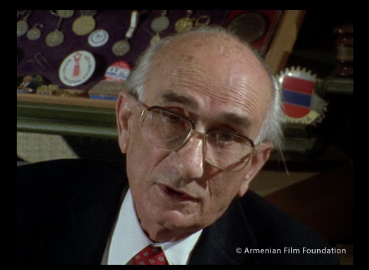
From the Armenian Genocide Collection: Arshag Dickranian
Arshag Dickranian had a happy childhood. The son of a wealthy Armenian merchant who worked in clothing manufacturing, Dickranian grew up in Adapazari, Turkey, home to around 20,000 Armenians. The diverse city was home to Greeks, Jews, and Turks as well as Armenians — all of whom peacefully coexisted.
Then, when he was 10, everything changed. His family, and all the other Armenians in the city, were forced to travel through Turkey, toward Syria in what has now become known as the Armenian Genocide.
They first journeyed to a railroad station about 30 minutes outside of town. They stayed there three days, living out in the open while rain poured down on them. Finally, an animal wagon with feces 6 inches deep on the floor came to transport them to their next location, Eskisehir. They then journeyed further inland, to Konya.
It was in Konya that the family managed to put a stop to their journey. Dickranian was one of the lucky ones. His father often used his wealth to bribe Turkish officers. He heard from other Armenians that he should do whatever he could to stay in Konya, and managed to keep the family there until the massacres were over. Dickranian’s uncle, aunt and cousins were not so lucky. They left Konya and the family never heard from them again.
Dickranian’s father managed to find a house in town the family could hide in. They were informed on by neighbors, but when the police came and put them in a car to be taken away, Dickranian’s father bribed the driver to take them to another house. In their first month hiding in Konya, they stayed in 60 different houses — attempting to not stay anywhere enough time to give informers the chance to see them.
Eventually, the family changed their name and began living as Turkish Muslims in the city. Dickranian’s father went to mosque, and Dickranian began attending a secret Armenian school in the attic of a house. When he went there each day, the eight students each entered the building separately, so as not to arouse suspicion.
They were never found out, however,, and by 1917, the massacres had all but stopped. Worried they’d begin again, Dickranian’s father sent him to Istanbul where he stayed with a cousin for a few days and then began attending an Armenian boarding school. The big, northern city was much safer for Armenians than inland Turkey. A few years later, Dickranian’s father, mother and sisters joined him, and in 1923 the family came to America.
By the time Dickranian gave his testimony to filmmaker Dr. J. Michael Hagopian in 1984, he had come along way. He had married, had children who then had grandchildren for him, and had become a prominent Los Angeles businessman with a school, the TCA Arshag Dickranian Armenian School in Hollywood, named after him.
Yet, Dickranian was still haunted by his memories. Even almost 70 years later, he could not stop himself from constantly thinking of his childhood experience.